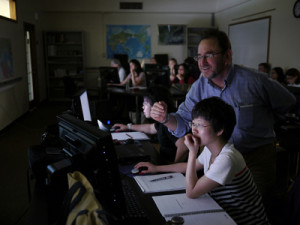Climate Smart Public Health

Jason Rodriguez, IRI
What do hot summer days in Beijing and heavy rains in rural Colombia have in common? Both are climate events that can trigger a host of public health calamities. And they’re just the tip of the iceberg when it comes to the ways that climate and health interact.
Despite strong connectivity between the two disciplines, getting the climate and health communities to interact can sometimes be a challenge. With that in mind, the International Research Institute for Climate and Society has partnered with the Mailman School of Public Healthand the Center for International Earth Science Information Network to run training course that brings these fields closer.
The course, called the Summer Institute on Climate Information for Public Health, is in its fourth year. Over those four years, it has brought together four dozen experts in public health, climatatology, and meteorology from more than 20 countries.
“Demand for the course keeps growing,” says Gilma Mantilla, who is the Summer Institute’s primary organizer. “This year, a record 212 people applied for only 10 slots.”
Over the course of two weeks, participants attended lectures and hands-on training sessions. These sessions helped participants delve into a research topic of their choosing, which they then presented to facilitators and other staff at IRI. The research questions they sought to answer were as diverse as their backgrounds and reasons for attending the Summer Institute.
Alum turned Facilitator
Rachel Lowe came to the Summer Institute in 2009 to answer questions about dengue fever prediction in Brazil as part of her Ph.D. Now a postdoctoral fellow at the International Centre for Theoretical Physics, Lowe returned this year, but this time as a facilitator.
Lowe was influenced to come back to help this year because of her experience in 2009. “Taking part in the course opens your eyes to the other areas of climate and health research apart from your own,” she said. Over the two weeks of this year’s course, Lowe used her experience from 2009 to guide daily discussion between the participants. She also led a session about her work on dengue in 2009.
“Rachel’s efforts really helped participants explore their topics more fully,” said Mantilla.
Sweltering City Streets
May Kei Liza To came to the Summer Institute from Hong Kong’s Department of Health looking to understand the implications climate change will have for health in Chinese cities. A doctor by training, To is still learning the ropes of using climate data. “I’m not familiar meteorological data handling,” she said. “But after attending this course, I have a clearer picture so that when I read reports and translate the information into recommendations, I can be more confident.”
To honed in on temperature changes in Beijing from 1971 to present for her final project. Her findings show that nighttime minimum temperatures have increased faster than daytime highs. They also show that the number of days above 35 degrees Celsius have increased by nearly three days every decade.
Her findings are significant for public health officials. During the European heat wave in 2003, for example, death rates in Paris more than doubled on the two nights that had record high minimums compared to other days during the heat wave. Closer to home for To, temperatures in Beijing cracked 35 and even 40 degrees Celsius during a July 2010 heat wave. This resulted in a 25% increase in hospital admissions for heatstroke.
To’s research is a warning signal to public health officials of what they’ll need to prepare for in a warmer climate.
Rural Rain
Nine thousand miles away, climate-related health issues are of a different nature but no less pressing. Salua Osorio came to the Summer Institute from Colombia looking to get a clearer picture on when malaria outbreaks occur in Colombia’s San Jose del Guaviare province.
Overall, more than five million people live in malaria-prone areas in Colombia. The risk of malaria outbreaks can increase when El Niño occurs. That’s because it tends to enhance rainfall in Colombia, creating conditions ripe for the breeding of mosquitoes that can transmit the disease.
Controlling for mosquitoes is the best way to combat malaria. However, as Osorio explained, performing control work in Colombia can be challenging. This is in part because of the mountainous terrain and diverse ecosystems.
Since completely eradicating malaria-carrying mosquitoes in Colombia is unlikely in the near future, the next best line of defense is preparing communities and regional health clinics for malaria so that outbreaks don’t become epidemics.
Osorio came to the Summer Institute with these issues in mind. Using IRI’s Data Library her project pulled out seasonal and interannual trends for malaria across the San Jose del Guaviare province. Public health officials can use that information to alert communities to take precautions to prevent malaria infections. It can also help health centers stay on guard and be ready for an outbreak should one occur.
Though she’s also a medical doctor by training, Osorio sees herself as occupying an ‘in-between’ space. “I’m in the middle,” Osorio said. “I’m trying to take results and translate them into action.” The Summer Institute is part of an effort by IRI and its partners to put Osorio and others working on climate and public health issues in a better position to do just that.
Brian Kahn is the communications coordinator at IRI. He also writes about IRI’s work on the State of the Planet blog and manages content for climate.gov , the National Oceanic and Atmospheric Administration’s climate portal.

You must be logged in to post a comment.